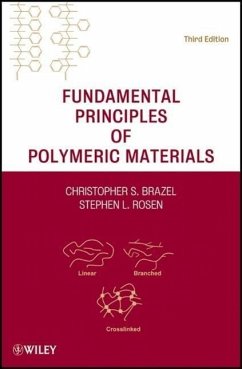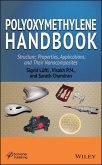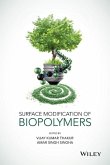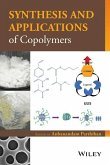- Gebundenes Buch
- Merkliste
- Auf die Merkliste
- Bewerten Bewerten
- Teilen
- Produkt teilen
- Produkterinnerung
- Produkterinnerung
New edition brings classic text up to date with the latest science, techniques, and applications
With its balanced presentation of polymer chemistry, physics, and engineering applications, the Third Edition of this classic text continues to instill readers with a solid understanding of the core concepts underlying polymeric materials. Both students and instructors have praised the text for its clear explanations and logical organization. It begins with molecular-level considerations and then progressively builds the reader's knowledge with discussions of bulk properties, mechanical…mehr
Andere Kunden interessierten sich auch für
![Mechanical Props Solid Polymer Mechanical Props Solid Polymer]() Ian I. WardMechanical Props Solid Polymer202,99 €
Ian I. WardMechanical Props Solid Polymer202,99 €![Polyoxymethylene Handbook Polyoxymethylene Handbook]() Sigrid LüftlPolyoxymethylene Handbook237,99 €
Sigrid LüftlPolyoxymethylene Handbook237,99 €![Surface Modification of Biopolymers Surface Modification of Biopolymers]() Surface Modification of Biopolymers182,99 €
Surface Modification of Biopolymers182,99 €![Polymer Rheology Polymer Rheology]() Montgomery T. ShawPolymer Rheology135,99 €
Montgomery T. ShawPolymer Rheology135,99 €![Synthesis and Applications of Copolymers Synthesis and Applications of Copolymers]() Anbanandam ParthibanSynthesis and Applications of Copolymers152,99 €
Anbanandam ParthibanSynthesis and Applications of Copolymers152,99 €![Patent Applications Patent Applications]() Thomas F. DeRosaPatent Applications277,99 €
Thomas F. DeRosaPatent Applications277,99 €![Microcellular Injection Molding Microcellular Injection Molding]() Jingyi XuMicrocellular Injection Molding206,99 €
Jingyi XuMicrocellular Injection Molding206,99 €-
-
-
New edition brings classic text up to date with the latest science, techniques, and applications
With its balanced presentation of polymer chemistry, physics, and engineering applications, the Third Edition of this classic text continues to instill readers with a solid understanding of the core concepts underlying polymeric materials. Both students and instructors have praised the text for its clear explanations and logical organization. It begins with molecular-level considerations and then progressively builds the reader's knowledge with discussions of bulk properties, mechanical behavior, and processing methods.
Following a brief introduction, Fundamental Principles of Polymeric Materials is divided into four parts:
Part 1: Polymer Fundamentals
Part 2: Polymer Synthesis
Part 3: Polymer Properties
Part 4: Polymer Processing and Performance
Thoroughly Updated and Revised
Readers familiar with the previous edition of this text will find that the organization and style have been updated with new material to help them grasp key concepts and discover the latest science, techniques, and applications. For example, there are new introductory sections on organic functional groups focusing on the structures found in condensation polymerizations. The text also features new techniques for polymer analysis, processing, and microencapsulation as well as emerging techniques such as atom transfer radical polymerization.
At the end of each chapter are problems--including many that are new to this edition--to test the reader's grasp of core concepts as they advance through the text. There are also references leading to the primary literature for further investigation of individual topics.
A classic in its field, this text enables students in chemistry, chemical engineering, materials science, and mechanical engineering to fully grasp and apply the fundamentals of polymeric materials, preparing them for more advanced coursework.
Hinweis: Dieser Artikel kann nur an eine deutsche Lieferadresse ausgeliefert werden.
With its balanced presentation of polymer chemistry, physics, and engineering applications, the Third Edition of this classic text continues to instill readers with a solid understanding of the core concepts underlying polymeric materials. Both students and instructors have praised the text for its clear explanations and logical organization. It begins with molecular-level considerations and then progressively builds the reader's knowledge with discussions of bulk properties, mechanical behavior, and processing methods.
Following a brief introduction, Fundamental Principles of Polymeric Materials is divided into four parts:
Part 1: Polymer Fundamentals
Part 2: Polymer Synthesis
Part 3: Polymer Properties
Part 4: Polymer Processing and Performance
Thoroughly Updated and Revised
Readers familiar with the previous edition of this text will find that the organization and style have been updated with new material to help them grasp key concepts and discover the latest science, techniques, and applications. For example, there are new introductory sections on organic functional groups focusing on the structures found in condensation polymerizations. The text also features new techniques for polymer analysis, processing, and microencapsulation as well as emerging techniques such as atom transfer radical polymerization.
At the end of each chapter are problems--including many that are new to this edition--to test the reader's grasp of core concepts as they advance through the text. There are also references leading to the primary literature for further investigation of individual topics.
A classic in its field, this text enables students in chemistry, chemical engineering, materials science, and mechanical engineering to fully grasp and apply the fundamentals of polymeric materials, preparing them for more advanced coursework.
Hinweis: Dieser Artikel kann nur an eine deutsche Lieferadresse ausgeliefert werden.
Produktdetails
- Produktdetails
- Verlag: Wiley & Sons
- 3. Aufl.
- Seitenzahl: 432
- Erscheinungstermin: 22. Mai 2012
- Englisch
- Abmessung: 257mm x 178mm x 23mm
- Gewicht: 910g
- ISBN-13: 9780470505427
- ISBN-10: 0470505427
- Artikelnr.: 34744674
- Herstellerkennzeichnung
- Libri GmbH
- Europaallee 1
- 36244 Bad Hersfeld
- gpsr@libri.de
- Verlag: Wiley & Sons
- 3. Aufl.
- Seitenzahl: 432
- Erscheinungstermin: 22. Mai 2012
- Englisch
- Abmessung: 257mm x 178mm x 23mm
- Gewicht: 910g
- ISBN-13: 9780470505427
- ISBN-10: 0470505427
- Artikelnr.: 34744674
- Herstellerkennzeichnung
- Libri GmbH
- Europaallee 1
- 36244 Bad Hersfeld
- gpsr@libri.de
Christopher S. Brazel, PHD, CHE, is Associate Professor of Chemical and Biological Engineering at The University of Alabama. His research interests include stimuli-responsive polymers, composite materials with magnetic nanoparticles, targeted block copolymer micelles, gels and networks for drug delivery, and microencapsulation. Previously, Dr. Brazel was a Fulbright Distinguished Scholar and Visiting Professor at the Institute for Science and Technology in Medicine, Keele University, UK. Stephen L. Rosen, PHD, CHE, is a former Professor of Chemical Engineering at the University of Missouri-Rolla. Dr. Rosen authored the two previous editions of Fundamental Principles of Polymeric Materials.
Preface xiii
Preface to the Second Edition xv
Acknowledgments xvii
1 Introduction 1
Problems 7
References 7
Part I. Polymer Fundamentals 9
2 Types of Polymers 11
2.1 Reaction to Temperature 11
2.2 Chemistry of Synthesis 12
2.3 Structure 19
2.4 Conclusions 30
Problems 30
Reference 34
3 Molecular Structure of Polymers 35
3.1 Types of Bonds 35
3.2 Bond Distances and Strengths 35
3.3 Bonding and Response to Temperature 37
3.4 Action of Solvents 38
3.5 Bonding and Molecular Structure 39
3.6 Stereoisomerism in Vinyl Polymers 40
3.7 Stereoisomerism in Diene Polymers 42
3.8 Summary 44
Problems 44
References 45
4 Polymer Morphology 46
4.1 Amorphous and Crystalline Polymers 47
4.2 The Effect of Polymer Structure, Temperature, and Solvent on
Crystallinity 48
4.3 The Effect of Crystallinity on Polymer Density 49
4.4 The Effect of Crystallinity on Mechanical Properties 50
4.5 The Effect of Crystallinity on Optical Properties 51
4.6 Models for the Crystalline Structure of Polymers 53
4.7 Extended Chain Crystals 56
4.8 Liquid Crystal Polymers 57
Problems 59
References 60
5 Characterization of Molecular Weight 61
5.1 Introduction 61
5.2 Average Molecular Weights 62
5.3 Determination of Average Molecular Weights 66
5.4 Molecular Weight Distributions 75
5.5 Gel Permeation (or Size-Exclusion) Chromatography (GPC, SEC) 79
5.6 Summary 85
Problems 86
References 89
6 Thermal Transitions in Polymers 91
6.1 Introduction 91
6.2 The Glass Transition 91
6.3 Molecular Motions in an Amorphous Polymer 92
6.4 Determination of T g 92
6.5 Factors that Influence T g 95
6.6 The Effect of Copolymerization on T g 97
6.7 The Thermodynamics of Melting 97
6.8 The Metastable Amorphous State 100
6.9 The Influence of Copolymerization on Thermal Properties 101
6.10 Effect of Additives on Thermal Properties 102
6.11 General Observations about T g and T m 103
6.12 Effects of Crosslinking 103
6.13 Thermal Degradation of Polymers 103
6.14 Other Thermal Transitions 104
Problems 104
References 106
7 Polymer Solubility and Solutions 107
7.1 Introduction 107
7.2 General Rules for Polymer Solubility 107
7.3 Typical Phase Behavior in Polymer-Solvent Systems 109
7.4 The Thermodynamic Basis of Polymer Solubility 110
7.5 The Solubility Parameter 112
7.6 Hansen's Three-Dimensional Solubility Parameter 114
7.7 The Flory-Huggins Theory 116
7.8 Properties of Dilute Solutions 118
7.9 Polymer-Polmyer-Common Solvent Systems 121
7.10 Polymer Solutions, Suspensions, and Emulsions 121
7.11 Concentrated Solutions: Plasticizers 122
Problems 124
References 126
Part II. Polymer Synthesis 129
8 Step-growth (condensation) Polymerization 131
8.1 Introduction 131
8.2 Statistics of Linear Step-Growth Polymerization 132
8.3 Number-Average Chain Lengths 133
8.4 Chain Lengths on a Weight Basis 136
8.5 Gel Formation 137
8.6 Kinetics of Polycondensation 142
Problems 143
References 145
9 Free-radical Addition (chain-growth) Polymerization 146
9.1 Introduction 146
9.2 Mechanism of Polymerization 147
9.3 Gelation in Addition Polymerization 148
9.4 Kinetics of Homogeneous Polymerization 149
9.5 Instantaneous Average Chain Lengths 153
9.6 Temperature Dependence of Rate and Chain Length 155
9.7 Chain Transfer and Reaction Inhibitors 157
9.8 Instantaneous Distributions in Free-Radical Addition Polymerization 160
9.9 Instantaneous Quantities 165
9.10 Cumulative Quantities 166
9.11 Relations Between Instantaneous and Cumulative Average Chain Lengths
for a Batch Reactor 169
9.12 Emulsion Polymerization 173
9.13 Kinetics of Emulsion Polymerization in Stage II, Case 2 176
9.14 Summary 180
Problems 180
References 183
10 Advanced Polymerization Methods 185
10.1 Introduction 185
10.2 Cationic Polymerization 185
10.3 Anionic Polymerization 186
10.4 Kinetics of Anionic Polymerization 192
10.5 Group-Transfer Polymerization 194
10.6 Atom Transfer Radical Polymerization 195
10.7 Heterogeneous Stereospecific Polymerization 196
10.8 Grafted Polymer Surfaces 202
10.9 Summary 203
Problems 203
References 205
11 Copolymerization 207
11.1 Introduction 207
11.2 Mechanism 207
11.3 Significance of Reactivity Ratios 209
11.4 Variation of Composition with Conversion 210
11.5 Copolymerization Kinetics 216
11.6 Penultimate Effects and Charge-Transfer Complexes 216
11.7 Summary 217
Problems 217
References 219
12 Polymerization Practice 220
12.1 Introduction 220
12.2 Bulk Polymerization 220
12.3 Gas-Phase Olefin Polymerization 225
12.4 Solution Polymerization 226
12.5 Interfacial Polycondensation 228
12.6 Suspension Polymerization 229
12.7 Emulsion Polymerization 232
12.8 Summary 234
Problems 234
References 235
Part III. Polymer Properties 237
13 Rubber Elasticity 239
13.1 Introduction 239
13.2 Thermodynamics of Elasticity 239
13.3 Statistics of Ideal Rubber Elasticity 246
13.4 Summary 248
Problems 248
References 249
14 Introduction to Viscous Flow and the Rheological Behavior of Polymers
250
14.1 Introduction 250
14.2 Basic Definitions 251
14.3 Relations Between Shear Force and Shear Rate: Flow Curves 252
14.4 Time-Dependent Flow Behavior 254
14.5 Polymer Melts and Solutions 255
14.6 Quantitative Representation of Flow Behavior 256
14.7 Temperature Dependence of Flow Properties 259
14.8 Influence of Molecular Weight on Flow Properties 262
14.9 The Effects of Pressure on Viscosity 263
14.10 Viscous Energy Dissipation 264
14.11 Poiseuille Flow 265
14.12 Turbulent Flow 268
14.13 Drag Reduction 269
14.14 Summary 271
Problems 271
References 274
15 Linear Viscoelasticity 276
15.1 Introduction 276
15.2 Mechanical Models for Linear Viscoelastic Response 276
15.3 The Four-Parameter Model and Molecular Response 285
15.4 Viscous or Elastic Response? The Deborah Number 288
15.5 Quantitative Approaches to Model Viscoelasticity 289
15.6 The Boltzmann Superposition Principle 293
15.7 Dynamic Mechanical Testing 297
15.8 Summary 304
Problems 304
References 307
16 Polymer Mechanical Properties 308
16.1 Introduction 308
16.2 Mechanical Properties of Polymers 308
16.3 Axial Tensiometers 309
16.4 Viscosity Measurement 311
16.5 Dynamic Mechanical Analysis: Techniques 316
16.6 Time-Temperature Superposition 323
16.7 Summary 329
Problems 329
References 332
Part IV. Polymer Processing and Performance 335
17 Processing 337
17.1 Introduction 337
17.2 Molding 337
17.3 Extrusion 344
17.4 Blow Molding 347
17.5 Rotational, Fluidized-Bed, and Slush Molding 348
17.6 Calendering 349
17.7 Sheet Forming (Thermoforming) 350
17.8 Stamping 351
17.9 Solution Casting 351
17.10 Casting 351
17.11 Reinforced Thermoset Molding 352
17.12 Fiber Spinning 353
17.13 Compounding 355
17.14 Lithography 358
17.15 Three-Dimensional (Rapid) Prototyping 358
17.16 Summary 359
Problems 359
References 360
18 Polymer Applications: Plastics and Plastic Additives 361
18.1 Introduction 361
18.2 Plastics 361
18.3 Mechanical Properties of Plastics 362
18.4 Contents of Plastic Compounds 363
18.5 Sheet Molding Compound for Plastics 371
18.6 Plastics Recycling 373
Problems 374
References 374
19 Polymer Applications: Rubbers And Thermoplastic Elastomers 375
19.1 Introduction 375
19.2 Thermoplastic Elastomers 375
19.3 Contents of Rubber Compounds 376
19.4 Rubber Compounding 379
References 379
20 Polymer Applications: Synthetic Fibers 380
20.1 Synthetic Fibers 380
20.2 Fiber Processing 380
20.3 Fiber Dyeing 381
20.4 Other Fiber Additives and Treatments 381
20.5 Effects of Heat and Moisture on Polymer Fibers 381
21 Polymer Applications: Surface Finishes And Coatings 383
21.1 Surface Finishes 383
21.2 Solventless Coatings 385
21.3 Electrodeposition 387
21.4 Microencapsulation 387
Problem 389
References 389
22 Polymer Applications: Adhesives 390
22.1 Adhesives 390
References 394
Index 395
Preface to the Second Edition xv
Acknowledgments xvii
1 Introduction 1
Problems 7
References 7
Part I. Polymer Fundamentals 9
2 Types of Polymers 11
2.1 Reaction to Temperature 11
2.2 Chemistry of Synthesis 12
2.3 Structure 19
2.4 Conclusions 30
Problems 30
Reference 34
3 Molecular Structure of Polymers 35
3.1 Types of Bonds 35
3.2 Bond Distances and Strengths 35
3.3 Bonding and Response to Temperature 37
3.4 Action of Solvents 38
3.5 Bonding and Molecular Structure 39
3.6 Stereoisomerism in Vinyl Polymers 40
3.7 Stereoisomerism in Diene Polymers 42
3.8 Summary 44
Problems 44
References 45
4 Polymer Morphology 46
4.1 Amorphous and Crystalline Polymers 47
4.2 The Effect of Polymer Structure, Temperature, and Solvent on
Crystallinity 48
4.3 The Effect of Crystallinity on Polymer Density 49
4.4 The Effect of Crystallinity on Mechanical Properties 50
4.5 The Effect of Crystallinity on Optical Properties 51
4.6 Models for the Crystalline Structure of Polymers 53
4.7 Extended Chain Crystals 56
4.8 Liquid Crystal Polymers 57
Problems 59
References 60
5 Characterization of Molecular Weight 61
5.1 Introduction 61
5.2 Average Molecular Weights 62
5.3 Determination of Average Molecular Weights 66
5.4 Molecular Weight Distributions 75
5.5 Gel Permeation (or Size-Exclusion) Chromatography (GPC, SEC) 79
5.6 Summary 85
Problems 86
References 89
6 Thermal Transitions in Polymers 91
6.1 Introduction 91
6.2 The Glass Transition 91
6.3 Molecular Motions in an Amorphous Polymer 92
6.4 Determination of T g 92
6.5 Factors that Influence T g 95
6.6 The Effect of Copolymerization on T g 97
6.7 The Thermodynamics of Melting 97
6.8 The Metastable Amorphous State 100
6.9 The Influence of Copolymerization on Thermal Properties 101
6.10 Effect of Additives on Thermal Properties 102
6.11 General Observations about T g and T m 103
6.12 Effects of Crosslinking 103
6.13 Thermal Degradation of Polymers 103
6.14 Other Thermal Transitions 104
Problems 104
References 106
7 Polymer Solubility and Solutions 107
7.1 Introduction 107
7.2 General Rules for Polymer Solubility 107
7.3 Typical Phase Behavior in Polymer-Solvent Systems 109
7.4 The Thermodynamic Basis of Polymer Solubility 110
7.5 The Solubility Parameter 112
7.6 Hansen's Three-Dimensional Solubility Parameter 114
7.7 The Flory-Huggins Theory 116
7.8 Properties of Dilute Solutions 118
7.9 Polymer-Polmyer-Common Solvent Systems 121
7.10 Polymer Solutions, Suspensions, and Emulsions 121
7.11 Concentrated Solutions: Plasticizers 122
Problems 124
References 126
Part II. Polymer Synthesis 129
8 Step-growth (condensation) Polymerization 131
8.1 Introduction 131
8.2 Statistics of Linear Step-Growth Polymerization 132
8.3 Number-Average Chain Lengths 133
8.4 Chain Lengths on a Weight Basis 136
8.5 Gel Formation 137
8.6 Kinetics of Polycondensation 142
Problems 143
References 145
9 Free-radical Addition (chain-growth) Polymerization 146
9.1 Introduction 146
9.2 Mechanism of Polymerization 147
9.3 Gelation in Addition Polymerization 148
9.4 Kinetics of Homogeneous Polymerization 149
9.5 Instantaneous Average Chain Lengths 153
9.6 Temperature Dependence of Rate and Chain Length 155
9.7 Chain Transfer and Reaction Inhibitors 157
9.8 Instantaneous Distributions in Free-Radical Addition Polymerization 160
9.9 Instantaneous Quantities 165
9.10 Cumulative Quantities 166
9.11 Relations Between Instantaneous and Cumulative Average Chain Lengths
for a Batch Reactor 169
9.12 Emulsion Polymerization 173
9.13 Kinetics of Emulsion Polymerization in Stage II, Case 2 176
9.14 Summary 180
Problems 180
References 183
10 Advanced Polymerization Methods 185
10.1 Introduction 185
10.2 Cationic Polymerization 185
10.3 Anionic Polymerization 186
10.4 Kinetics of Anionic Polymerization 192
10.5 Group-Transfer Polymerization 194
10.6 Atom Transfer Radical Polymerization 195
10.7 Heterogeneous Stereospecific Polymerization 196
10.8 Grafted Polymer Surfaces 202
10.9 Summary 203
Problems 203
References 205
11 Copolymerization 207
11.1 Introduction 207
11.2 Mechanism 207
11.3 Significance of Reactivity Ratios 209
11.4 Variation of Composition with Conversion 210
11.5 Copolymerization Kinetics 216
11.6 Penultimate Effects and Charge-Transfer Complexes 216
11.7 Summary 217
Problems 217
References 219
12 Polymerization Practice 220
12.1 Introduction 220
12.2 Bulk Polymerization 220
12.3 Gas-Phase Olefin Polymerization 225
12.4 Solution Polymerization 226
12.5 Interfacial Polycondensation 228
12.6 Suspension Polymerization 229
12.7 Emulsion Polymerization 232
12.8 Summary 234
Problems 234
References 235
Part III. Polymer Properties 237
13 Rubber Elasticity 239
13.1 Introduction 239
13.2 Thermodynamics of Elasticity 239
13.3 Statistics of Ideal Rubber Elasticity 246
13.4 Summary 248
Problems 248
References 249
14 Introduction to Viscous Flow and the Rheological Behavior of Polymers
250
14.1 Introduction 250
14.2 Basic Definitions 251
14.3 Relations Between Shear Force and Shear Rate: Flow Curves 252
14.4 Time-Dependent Flow Behavior 254
14.5 Polymer Melts and Solutions 255
14.6 Quantitative Representation of Flow Behavior 256
14.7 Temperature Dependence of Flow Properties 259
14.8 Influence of Molecular Weight on Flow Properties 262
14.9 The Effects of Pressure on Viscosity 263
14.10 Viscous Energy Dissipation 264
14.11 Poiseuille Flow 265
14.12 Turbulent Flow 268
14.13 Drag Reduction 269
14.14 Summary 271
Problems 271
References 274
15 Linear Viscoelasticity 276
15.1 Introduction 276
15.2 Mechanical Models for Linear Viscoelastic Response 276
15.3 The Four-Parameter Model and Molecular Response 285
15.4 Viscous or Elastic Response? The Deborah Number 288
15.5 Quantitative Approaches to Model Viscoelasticity 289
15.6 The Boltzmann Superposition Principle 293
15.7 Dynamic Mechanical Testing 297
15.8 Summary 304
Problems 304
References 307
16 Polymer Mechanical Properties 308
16.1 Introduction 308
16.2 Mechanical Properties of Polymers 308
16.3 Axial Tensiometers 309
16.4 Viscosity Measurement 311
16.5 Dynamic Mechanical Analysis: Techniques 316
16.6 Time-Temperature Superposition 323
16.7 Summary 329
Problems 329
References 332
Part IV. Polymer Processing and Performance 335
17 Processing 337
17.1 Introduction 337
17.2 Molding 337
17.3 Extrusion 344
17.4 Blow Molding 347
17.5 Rotational, Fluidized-Bed, and Slush Molding 348
17.6 Calendering 349
17.7 Sheet Forming (Thermoforming) 350
17.8 Stamping 351
17.9 Solution Casting 351
17.10 Casting 351
17.11 Reinforced Thermoset Molding 352
17.12 Fiber Spinning 353
17.13 Compounding 355
17.14 Lithography 358
17.15 Three-Dimensional (Rapid) Prototyping 358
17.16 Summary 359
Problems 359
References 360
18 Polymer Applications: Plastics and Plastic Additives 361
18.1 Introduction 361
18.2 Plastics 361
18.3 Mechanical Properties of Plastics 362
18.4 Contents of Plastic Compounds 363
18.5 Sheet Molding Compound for Plastics 371
18.6 Plastics Recycling 373
Problems 374
References 374
19 Polymer Applications: Rubbers And Thermoplastic Elastomers 375
19.1 Introduction 375
19.2 Thermoplastic Elastomers 375
19.3 Contents of Rubber Compounds 376
19.4 Rubber Compounding 379
References 379
20 Polymer Applications: Synthetic Fibers 380
20.1 Synthetic Fibers 380
20.2 Fiber Processing 380
20.3 Fiber Dyeing 381
20.4 Other Fiber Additives and Treatments 381
20.5 Effects of Heat and Moisture on Polymer Fibers 381
21 Polymer Applications: Surface Finishes And Coatings 383
21.1 Surface Finishes 383
21.2 Solventless Coatings 385
21.3 Electrodeposition 387
21.4 Microencapsulation 387
Problem 389
References 389
22 Polymer Applications: Adhesives 390
22.1 Adhesives 390
References 394
Index 395
Preface xiii
Preface to the Second Edition xv
Acknowledgments xvii
1 Introduction 1
Problems 7
References 7
Part I. Polymer Fundamentals 9
2 Types of Polymers 11
2.1 Reaction to Temperature 11
2.2 Chemistry of Synthesis 12
2.3 Structure 19
2.4 Conclusions 30
Problems 30
Reference 34
3 Molecular Structure of Polymers 35
3.1 Types of Bonds 35
3.2 Bond Distances and Strengths 35
3.3 Bonding and Response to Temperature 37
3.4 Action of Solvents 38
3.5 Bonding and Molecular Structure 39
3.6 Stereoisomerism in Vinyl Polymers 40
3.7 Stereoisomerism in Diene Polymers 42
3.8 Summary 44
Problems 44
References 45
4 Polymer Morphology 46
4.1 Amorphous and Crystalline Polymers 47
4.2 The Effect of Polymer Structure, Temperature, and Solvent on
Crystallinity 48
4.3 The Effect of Crystallinity on Polymer Density 49
4.4 The Effect of Crystallinity on Mechanical Properties 50
4.5 The Effect of Crystallinity on Optical Properties 51
4.6 Models for the Crystalline Structure of Polymers 53
4.7 Extended Chain Crystals 56
4.8 Liquid Crystal Polymers 57
Problems 59
References 60
5 Characterization of Molecular Weight 61
5.1 Introduction 61
5.2 Average Molecular Weights 62
5.3 Determination of Average Molecular Weights 66
5.4 Molecular Weight Distributions 75
5.5 Gel Permeation (or Size-Exclusion) Chromatography (GPC, SEC) 79
5.6 Summary 85
Problems 86
References 89
6 Thermal Transitions in Polymers 91
6.1 Introduction 91
6.2 The Glass Transition 91
6.3 Molecular Motions in an Amorphous Polymer 92
6.4 Determination of T g 92
6.5 Factors that Influence T g 95
6.6 The Effect of Copolymerization on T g 97
6.7 The Thermodynamics of Melting 97
6.8 The Metastable Amorphous State 100
6.9 The Influence of Copolymerization on Thermal Properties 101
6.10 Effect of Additives on Thermal Properties 102
6.11 General Observations about T g and T m 103
6.12 Effects of Crosslinking 103
6.13 Thermal Degradation of Polymers 103
6.14 Other Thermal Transitions 104
Problems 104
References 106
7 Polymer Solubility and Solutions 107
7.1 Introduction 107
7.2 General Rules for Polymer Solubility 107
7.3 Typical Phase Behavior in Polymer-Solvent Systems 109
7.4 The Thermodynamic Basis of Polymer Solubility 110
7.5 The Solubility Parameter 112
7.6 Hansen's Three-Dimensional Solubility Parameter 114
7.7 The Flory-Huggins Theory 116
7.8 Properties of Dilute Solutions 118
7.9 Polymer-Polmyer-Common Solvent Systems 121
7.10 Polymer Solutions, Suspensions, and Emulsions 121
7.11 Concentrated Solutions: Plasticizers 122
Problems 124
References 126
Part II. Polymer Synthesis 129
8 Step-growth (condensation) Polymerization 131
8.1 Introduction 131
8.2 Statistics of Linear Step-Growth Polymerization 132
8.3 Number-Average Chain Lengths 133
8.4 Chain Lengths on a Weight Basis 136
8.5 Gel Formation 137
8.6 Kinetics of Polycondensation 142
Problems 143
References 145
9 Free-radical Addition (chain-growth) Polymerization 146
9.1 Introduction 146
9.2 Mechanism of Polymerization 147
9.3 Gelation in Addition Polymerization 148
9.4 Kinetics of Homogeneous Polymerization 149
9.5 Instantaneous Average Chain Lengths 153
9.6 Temperature Dependence of Rate and Chain Length 155
9.7 Chain Transfer and Reaction Inhibitors 157
9.8 Instantaneous Distributions in Free-Radical Addition Polymerization 160
9.9 Instantaneous Quantities 165
9.10 Cumulative Quantities 166
9.11 Relations Between Instantaneous and Cumulative Average Chain Lengths
for a Batch Reactor 169
9.12 Emulsion Polymerization 173
9.13 Kinetics of Emulsion Polymerization in Stage II, Case 2 176
9.14 Summary 180
Problems 180
References 183
10 Advanced Polymerization Methods 185
10.1 Introduction 185
10.2 Cationic Polymerization 185
10.3 Anionic Polymerization 186
10.4 Kinetics of Anionic Polymerization 192
10.5 Group-Transfer Polymerization 194
10.6 Atom Transfer Radical Polymerization 195
10.7 Heterogeneous Stereospecific Polymerization 196
10.8 Grafted Polymer Surfaces 202
10.9 Summary 203
Problems 203
References 205
11 Copolymerization 207
11.1 Introduction 207
11.2 Mechanism 207
11.3 Significance of Reactivity Ratios 209
11.4 Variation of Composition with Conversion 210
11.5 Copolymerization Kinetics 216
11.6 Penultimate Effects and Charge-Transfer Complexes 216
11.7 Summary 217
Problems 217
References 219
12 Polymerization Practice 220
12.1 Introduction 220
12.2 Bulk Polymerization 220
12.3 Gas-Phase Olefin Polymerization 225
12.4 Solution Polymerization 226
12.5 Interfacial Polycondensation 228
12.6 Suspension Polymerization 229
12.7 Emulsion Polymerization 232
12.8 Summary 234
Problems 234
References 235
Part III. Polymer Properties 237
13 Rubber Elasticity 239
13.1 Introduction 239
13.2 Thermodynamics of Elasticity 239
13.3 Statistics of Ideal Rubber Elasticity 246
13.4 Summary 248
Problems 248
References 249
14 Introduction to Viscous Flow and the Rheological Behavior of Polymers
250
14.1 Introduction 250
14.2 Basic Definitions 251
14.3 Relations Between Shear Force and Shear Rate: Flow Curves 252
14.4 Time-Dependent Flow Behavior 254
14.5 Polymer Melts and Solutions 255
14.6 Quantitative Representation of Flow Behavior 256
14.7 Temperature Dependence of Flow Properties 259
14.8 Influence of Molecular Weight on Flow Properties 262
14.9 The Effects of Pressure on Viscosity 263
14.10 Viscous Energy Dissipation 264
14.11 Poiseuille Flow 265
14.12 Turbulent Flow 268
14.13 Drag Reduction 269
14.14 Summary 271
Problems 271
References 274
15 Linear Viscoelasticity 276
15.1 Introduction 276
15.2 Mechanical Models for Linear Viscoelastic Response 276
15.3 The Four-Parameter Model and Molecular Response 285
15.4 Viscous or Elastic Response? The Deborah Number 288
15.5 Quantitative Approaches to Model Viscoelasticity 289
15.6 The Boltzmann Superposition Principle 293
15.7 Dynamic Mechanical Testing 297
15.8 Summary 304
Problems 304
References 307
16 Polymer Mechanical Properties 308
16.1 Introduction 308
16.2 Mechanical Properties of Polymers 308
16.3 Axial Tensiometers 309
16.4 Viscosity Measurement 311
16.5 Dynamic Mechanical Analysis: Techniques 316
16.6 Time-Temperature Superposition 323
16.7 Summary 329
Problems 329
References 332
Part IV. Polymer Processing and Performance 335
17 Processing 337
17.1 Introduction 337
17.2 Molding 337
17.3 Extrusion 344
17.4 Blow Molding 347
17.5 Rotational, Fluidized-Bed, and Slush Molding 348
17.6 Calendering 349
17.7 Sheet Forming (Thermoforming) 350
17.8 Stamping 351
17.9 Solution Casting 351
17.10 Casting 351
17.11 Reinforced Thermoset Molding 352
17.12 Fiber Spinning 353
17.13 Compounding 355
17.14 Lithography 358
17.15 Three-Dimensional (Rapid) Prototyping 358
17.16 Summary 359
Problems 359
References 360
18 Polymer Applications: Plastics and Plastic Additives 361
18.1 Introduction 361
18.2 Plastics 361
18.3 Mechanical Properties of Plastics 362
18.4 Contents of Plastic Compounds 363
18.5 Sheet Molding Compound for Plastics 371
18.6 Plastics Recycling 373
Problems 374
References 374
19 Polymer Applications: Rubbers And Thermoplastic Elastomers 375
19.1 Introduction 375
19.2 Thermoplastic Elastomers 375
19.3 Contents of Rubber Compounds 376
19.4 Rubber Compounding 379
References 379
20 Polymer Applications: Synthetic Fibers 380
20.1 Synthetic Fibers 380
20.2 Fiber Processing 380
20.3 Fiber Dyeing 381
20.4 Other Fiber Additives and Treatments 381
20.5 Effects of Heat and Moisture on Polymer Fibers 381
21 Polymer Applications: Surface Finishes And Coatings 383
21.1 Surface Finishes 383
21.2 Solventless Coatings 385
21.3 Electrodeposition 387
21.4 Microencapsulation 387
Problem 389
References 389
22 Polymer Applications: Adhesives 390
22.1 Adhesives 390
References 394
Index 395
Preface to the Second Edition xv
Acknowledgments xvii
1 Introduction 1
Problems 7
References 7
Part I. Polymer Fundamentals 9
2 Types of Polymers 11
2.1 Reaction to Temperature 11
2.2 Chemistry of Synthesis 12
2.3 Structure 19
2.4 Conclusions 30
Problems 30
Reference 34
3 Molecular Structure of Polymers 35
3.1 Types of Bonds 35
3.2 Bond Distances and Strengths 35
3.3 Bonding and Response to Temperature 37
3.4 Action of Solvents 38
3.5 Bonding and Molecular Structure 39
3.6 Stereoisomerism in Vinyl Polymers 40
3.7 Stereoisomerism in Diene Polymers 42
3.8 Summary 44
Problems 44
References 45
4 Polymer Morphology 46
4.1 Amorphous and Crystalline Polymers 47
4.2 The Effect of Polymer Structure, Temperature, and Solvent on
Crystallinity 48
4.3 The Effect of Crystallinity on Polymer Density 49
4.4 The Effect of Crystallinity on Mechanical Properties 50
4.5 The Effect of Crystallinity on Optical Properties 51
4.6 Models for the Crystalline Structure of Polymers 53
4.7 Extended Chain Crystals 56
4.8 Liquid Crystal Polymers 57
Problems 59
References 60
5 Characterization of Molecular Weight 61
5.1 Introduction 61
5.2 Average Molecular Weights 62
5.3 Determination of Average Molecular Weights 66
5.4 Molecular Weight Distributions 75
5.5 Gel Permeation (or Size-Exclusion) Chromatography (GPC, SEC) 79
5.6 Summary 85
Problems 86
References 89
6 Thermal Transitions in Polymers 91
6.1 Introduction 91
6.2 The Glass Transition 91
6.3 Molecular Motions in an Amorphous Polymer 92
6.4 Determination of T g 92
6.5 Factors that Influence T g 95
6.6 The Effect of Copolymerization on T g 97
6.7 The Thermodynamics of Melting 97
6.8 The Metastable Amorphous State 100
6.9 The Influence of Copolymerization on Thermal Properties 101
6.10 Effect of Additives on Thermal Properties 102
6.11 General Observations about T g and T m 103
6.12 Effects of Crosslinking 103
6.13 Thermal Degradation of Polymers 103
6.14 Other Thermal Transitions 104
Problems 104
References 106
7 Polymer Solubility and Solutions 107
7.1 Introduction 107
7.2 General Rules for Polymer Solubility 107
7.3 Typical Phase Behavior in Polymer-Solvent Systems 109
7.4 The Thermodynamic Basis of Polymer Solubility 110
7.5 The Solubility Parameter 112
7.6 Hansen's Three-Dimensional Solubility Parameter 114
7.7 The Flory-Huggins Theory 116
7.8 Properties of Dilute Solutions 118
7.9 Polymer-Polmyer-Common Solvent Systems 121
7.10 Polymer Solutions, Suspensions, and Emulsions 121
7.11 Concentrated Solutions: Plasticizers 122
Problems 124
References 126
Part II. Polymer Synthesis 129
8 Step-growth (condensation) Polymerization 131
8.1 Introduction 131
8.2 Statistics of Linear Step-Growth Polymerization 132
8.3 Number-Average Chain Lengths 133
8.4 Chain Lengths on a Weight Basis 136
8.5 Gel Formation 137
8.6 Kinetics of Polycondensation 142
Problems 143
References 145
9 Free-radical Addition (chain-growth) Polymerization 146
9.1 Introduction 146
9.2 Mechanism of Polymerization 147
9.3 Gelation in Addition Polymerization 148
9.4 Kinetics of Homogeneous Polymerization 149
9.5 Instantaneous Average Chain Lengths 153
9.6 Temperature Dependence of Rate and Chain Length 155
9.7 Chain Transfer and Reaction Inhibitors 157
9.8 Instantaneous Distributions in Free-Radical Addition Polymerization 160
9.9 Instantaneous Quantities 165
9.10 Cumulative Quantities 166
9.11 Relations Between Instantaneous and Cumulative Average Chain Lengths
for a Batch Reactor 169
9.12 Emulsion Polymerization 173
9.13 Kinetics of Emulsion Polymerization in Stage II, Case 2 176
9.14 Summary 180
Problems 180
References 183
10 Advanced Polymerization Methods 185
10.1 Introduction 185
10.2 Cationic Polymerization 185
10.3 Anionic Polymerization 186
10.4 Kinetics of Anionic Polymerization 192
10.5 Group-Transfer Polymerization 194
10.6 Atom Transfer Radical Polymerization 195
10.7 Heterogeneous Stereospecific Polymerization 196
10.8 Grafted Polymer Surfaces 202
10.9 Summary 203
Problems 203
References 205
11 Copolymerization 207
11.1 Introduction 207
11.2 Mechanism 207
11.3 Significance of Reactivity Ratios 209
11.4 Variation of Composition with Conversion 210
11.5 Copolymerization Kinetics 216
11.6 Penultimate Effects and Charge-Transfer Complexes 216
11.7 Summary 217
Problems 217
References 219
12 Polymerization Practice 220
12.1 Introduction 220
12.2 Bulk Polymerization 220
12.3 Gas-Phase Olefin Polymerization 225
12.4 Solution Polymerization 226
12.5 Interfacial Polycondensation 228
12.6 Suspension Polymerization 229
12.7 Emulsion Polymerization 232
12.8 Summary 234
Problems 234
References 235
Part III. Polymer Properties 237
13 Rubber Elasticity 239
13.1 Introduction 239
13.2 Thermodynamics of Elasticity 239
13.3 Statistics of Ideal Rubber Elasticity 246
13.4 Summary 248
Problems 248
References 249
14 Introduction to Viscous Flow and the Rheological Behavior of Polymers
250
14.1 Introduction 250
14.2 Basic Definitions 251
14.3 Relations Between Shear Force and Shear Rate: Flow Curves 252
14.4 Time-Dependent Flow Behavior 254
14.5 Polymer Melts and Solutions 255
14.6 Quantitative Representation of Flow Behavior 256
14.7 Temperature Dependence of Flow Properties 259
14.8 Influence of Molecular Weight on Flow Properties 262
14.9 The Effects of Pressure on Viscosity 263
14.10 Viscous Energy Dissipation 264
14.11 Poiseuille Flow 265
14.12 Turbulent Flow 268
14.13 Drag Reduction 269
14.14 Summary 271
Problems 271
References 274
15 Linear Viscoelasticity 276
15.1 Introduction 276
15.2 Mechanical Models for Linear Viscoelastic Response 276
15.3 The Four-Parameter Model and Molecular Response 285
15.4 Viscous or Elastic Response? The Deborah Number 288
15.5 Quantitative Approaches to Model Viscoelasticity 289
15.6 The Boltzmann Superposition Principle 293
15.7 Dynamic Mechanical Testing 297
15.8 Summary 304
Problems 304
References 307
16 Polymer Mechanical Properties 308
16.1 Introduction 308
16.2 Mechanical Properties of Polymers 308
16.3 Axial Tensiometers 309
16.4 Viscosity Measurement 311
16.5 Dynamic Mechanical Analysis: Techniques 316
16.6 Time-Temperature Superposition 323
16.7 Summary 329
Problems 329
References 332
Part IV. Polymer Processing and Performance 335
17 Processing 337
17.1 Introduction 337
17.2 Molding 337
17.3 Extrusion 344
17.4 Blow Molding 347
17.5 Rotational, Fluidized-Bed, and Slush Molding 348
17.6 Calendering 349
17.7 Sheet Forming (Thermoforming) 350
17.8 Stamping 351
17.9 Solution Casting 351
17.10 Casting 351
17.11 Reinforced Thermoset Molding 352
17.12 Fiber Spinning 353
17.13 Compounding 355
17.14 Lithography 358
17.15 Three-Dimensional (Rapid) Prototyping 358
17.16 Summary 359
Problems 359
References 360
18 Polymer Applications: Plastics and Plastic Additives 361
18.1 Introduction 361
18.2 Plastics 361
18.3 Mechanical Properties of Plastics 362
18.4 Contents of Plastic Compounds 363
18.5 Sheet Molding Compound for Plastics 371
18.6 Plastics Recycling 373
Problems 374
References 374
19 Polymer Applications: Rubbers And Thermoplastic Elastomers 375
19.1 Introduction 375
19.2 Thermoplastic Elastomers 375
19.3 Contents of Rubber Compounds 376
19.4 Rubber Compounding 379
References 379
20 Polymer Applications: Synthetic Fibers 380
20.1 Synthetic Fibers 380
20.2 Fiber Processing 380
20.3 Fiber Dyeing 381
20.4 Other Fiber Additives and Treatments 381
20.5 Effects of Heat and Moisture on Polymer Fibers 381
21 Polymer Applications: Surface Finishes And Coatings 383
21.1 Surface Finishes 383
21.2 Solventless Coatings 385
21.3 Electrodeposition 387
21.4 Microencapsulation 387
Problem 389
References 389
22 Polymer Applications: Adhesives 390
22.1 Adhesives 390
References 394
Index 395








